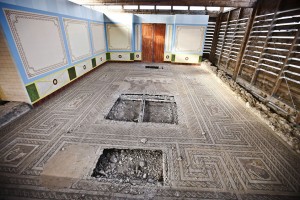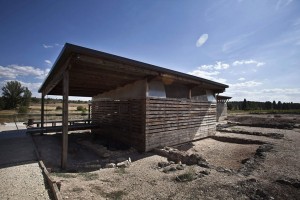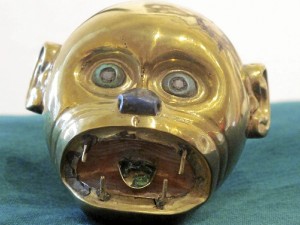 Something on the order of 25,000 people, mainly women, were convicted of witchcraft and executed in Germany between 1500 and 1782. By some estimates, that’s 40% of all the witches killed in Europe. Witchcraft had been declared heresy by Pope John XXII in 1320 and the Inquisition persecuted accused witches as heretics, but the definition of the witch in league with Satan with her familiars and sabbats that resulted in so much murderous mass hysteria was a product of the late 15th century.
Something on the order of 25,000 people, mainly women, were convicted of witchcraft and executed in Germany between 1500 and 1782. By some estimates, that’s 40% of all the witches killed in Europe. Witchcraft had been declared heresy by Pope John XXII in 1320 and the Inquisition persecuted accused witches as heretics, but the definition of the witch in league with Satan with her familiars and sabbats that resulted in so much murderous mass hysteria was a product of the late 15th century.
Pope Innocent VIII’s Summis desiderantes affectibus bull of 1484 specifically singles out Germany as a nest of Satanic witchcraft, rife with impotence, sores, and both human and livestock abortions.
It has indeed lately come to Our ears, not without afflicting Us with bitter sorrow, that in some parts of Northern Germany, as well as in the provinces, townships, territories, districts, and dioceses of Mainz, Cologne, Tréves, Salzburg, and Bremen, many persons of both sexes, unmindful of their own salvation and straying from the Catholic Faith, have abandoned themselves to devils, incubi and succubi, and by their incantations, spells, conjurations, and other accursed charms and crafts, enormities and horrid offences, have slain infants yet in the mother’s womb, as also the offspring of cattle, have blasted the produce of the earth, the grapes of the vine, the fruits of the trees, nay, men and women, beasts of burthen, herd-beasts, as well as animals of other kinds, vineyards, orchards, meadows, pasture-land, corn, wheat, and all other cereals; these wretches furthermore afflict and torment men and women, beasts of burthen, herd-beasts, as well as animals of other kinds, with terrible and piteous pains and sore diseases, both internal and external; they hinder men from performing the sexual act and women from conceiving, whence husbands cannot know their wives nor wives receive their husbands; over and above this, they blasphemously renounce that Faith which is theirs by the Sacrament of Baptism, and at the instigation of the Enemy of Mankind they do not shrink from committing and perpetrating the foulest abominations and filthiest excesses to the deadly peril of their own souls, whereby they outrage the Divine Majesty and are a cause of scandal and danger to very many.
Innocent further laments that the Inquisitors he has dispatched to address the dire state of German souls, two Dominican theology professors named Henry Kramer and James Sprenger, are being prevented from doing their holy duty by local clergy and power brokers who insist against all evidence that their towns are free of the stain of witchcraft and thus the Inquisitors have no legal right to ply their trade.
In fact, Kramer and Sprenger had been kicked out of the Tyrol earlier that year where the local bishop called Kramer a senile old man. The bull insists that Kramer and Sprenger be given every power their black hearts desire and that every knee shall bend or else face excommunication/the interdict.
 Two years later in 1486, Kramer and Sprenger wrote the Malleus Maleficarum (the Hammer of Witches), a book detailing how to identify witches, counter their magic and prosecute them to the fullest extent of the law. The text of Innocent’s bull was published as the preface.
Two years later in 1486, Kramer and Sprenger wrote the Malleus Maleficarum (the Hammer of Witches), a book detailing how to identify witches, counter their magic and prosecute them to the fullest extent of the law. The text of Innocent’s bull was published as the preface.
Now retired Protestant minister and witch trial expert Hartmut Hegeler is reclaiming that early tradition of running witch hunters out of town. He and a group of history buffs/activists are working with municipal governments to posthumously exonerate the witches who were unjustly put to death. So far they have succeeded in getting eight cities to absolve convicted witches of whatever they were accused of, and the trend is picking up steam. Five of the eight cities exonerated their witches just this year and people are reaching out to Hegeler from cities all over the country.
Recently he has been in contact with Green Party officials in the Rhineland town of Rheinbach, where they have reportedly proposed the rehabilitation of 130 witches who were burned at the stake in the area around 1631. The city plans to address the motion next week, according to regional daily Express. But no particular party claims ownership to the cause, and inquiries and support have come from officials across the German political spectrum, Hegeler says.
Early this month, Hegeler also filed a request with the city of Cologne to rehabilitate Katharina Henoth, who was strangled and burned at the stake there in 1627 for allegedly causing a plague of caterpillars at a monastery. He has also contacted the office of Cardinal Joachim Meisner, the archbishop of Cologne, in hopes that the Catholic Church too might make a public statement to acknowledge the unjust execution. While city and municipal courts were generally responsible for witch trials, church forces often spurred their progress, Hegeler says.
There are some towns that refuse to engage the issue. The town of Aachen recently rejected an exoneration request for a 13-year-old girl who was executed for witchcraft in 1649. Another city, Büdingen, said they had bigger fish to fry too, although word on the street is they didn’t want to piss off a local noble family which was deeply involved in the witch trials and still has enough local influence to ensure the town does not delve into their witch blood-stained past.
 Four of the largest witch trials were held in Germany — Trier (1581–1593), Fulda (1603–1606), Würzburg (1626–1631) and Bamberg (1626–1631). Three hundred and sixty-eight people were killed at Trier, the largest mass execution in peacetime Europe. Between 300 and 600 died in Bamberg. I think Hegeler should work on the big ones instead of going witch by witch. A little reverse mass hysteria, if you will. Edit: He is working on the big ones! Hegeler has been tirelessly advocating that cities including Bamberg exonerate the victims of witchcraft trials.
Four of the largest witch trials were held in Germany — Trier (1581–1593), Fulda (1603–1606), Würzburg (1626–1631) and Bamberg (1626–1631). Three hundred and sixty-eight people were killed at Trier, the largest mass execution in peacetime Europe. Between 300 and 600 died in Bamberg. I think Hegeler should work on the big ones instead of going witch by witch. A little reverse mass hysteria, if you will. Edit: He is working on the big ones! Hegeler has been tirelessly advocating that cities including Bamberg exonerate the victims of witchcraft trials.
Read more about Hartmut Hegeler’s witch exoneration efforts in this pdf file he has compiled.




